THE “GUAI” IDEAS…
Guai Shu Shu is a “Shu Shu” that is Guai (literally translated to an uncle that has a bewildered behavior or behaved in an odd or even abnormal manner). Yes, Guai Shu Shu never contented with the present state of his surroundings; he like to explore; he like to change and he likes to mix and match. In his mind, he is thinking: “what would happen if chocolates were added to breads; breads were added to eggs; eggs were added to cakes; cakes were mixed with milk; milk were mixed with banana; banana were mixed with sugars, sugars were mixed with scones, scones mixed with donuts…………..etc. etc.. etc.”
After dinner, he took out a mixing bowl and a baking tin, he wasted no time wanted to experiment and confirm his new mix and match ideas. He started to bake this “modified version” of egg puddings or bread puddings or chocolate puddings???? He knows for sure that if no actions were taken to address these idle “chocolates, breads and bananas” in the kitchen, they would soon be “kicked” out of the house…
BREAD PUDDINGS “DEFINED”….
As is consistent with my Food Preparation Series and Creative Food Series, I will have some quotes from “Wikipedia” with regards to the food items that I am going to post. I believed that readers should have a better knowledge on the topics instead of just “whole heartedly” follow what I mentioned in the post.
“Bread pudding is a bread-based dessert popular in many countries’ cuisine, including that of Cuba, Ireland, Great Britain, France, Belgium,Puerto Rico, Mexico, Malta, Argentina, Louisiana Creole, Germany, and the southern United States. In other languages, its name is a translation of “bread pudding” or even just “pudding”, for example “pudín” or “budín” in Spanish; also in Spanish another name is “migas” (crumbs). In Mexico, there is a similar dish, capirotada.
There is no fixed recipe, but it is usually made using stale (usually left-over) bread, and some combination of ingredients like milk, egg, suet, sugar or syrup, dried fruit, and spices such as cinnamon, nutmeg, mace or vanilla. The bread is soaked in the liquids, mixed with the other ingredients, and baked.
It may be served with a sweet sauce of some sort, such as whiskey sauce, rum sauce, or caramel sauce, but is typically sprinkled with sugar and eaten warm in squares or slices. In Canada it is often made with maple syrup. In Malaysia, bread pudding is eaten with custard sauce. In Hong Kong, bread pudding is usually served with vanilla cream dressing. In Mecklenburg-Vorpommern, Germany, black bread is used to make “black bread pudding” (Schwarzbrot pudding). In Hungary it is called ‘Máglyarakás’ which is baked with whipped egg whites on top of it.
RECIPE FOR BREAD PUDDINGS……? SUBSTITUTABLE?…
Besides understanding what is the output, it would be nice to spend a bit of time to understand the ingredients used and the rationale of using such ingredients. Understanding the role of the ingredients will help you to find suitable substitutes and exploring your own new recipes.. Theory is still important…
In the above quote, it is stated clearly that “THERE IS NO FIXED RECIPE” and usually made from… The important word is no fixed recipe. You can easily made substitutions to almost everything but the bread and eggs. Even then I have substitute the bread with some Chinese New Year Cookies and you can read it here.
The theory behind the proposed usage of bread and eggs are the need to have some glutens and liquids to hold the “mixture” in shape.. Any things that contain gluten are possibilities to explore. Gluten is a protein in the flour that when combines with water will produce an elastic and web like structure and if it is too technical, just think of it as wheat flour. For example, bread, scones, muffins, biscuits, breakfast cereals, donuts…..These are called “strengtheners”…..
However, baking flour alone will yield you nothing, you need liquids… Eggs are used because it is a perfect binding agent (meaning hold the flour together) and give you a nice aroma. Eggs here serves both as a role of “strengtheners and tenderizers”. Other liquids can be explore such as milk, melted fats (butters), waters.. Use your sense to mix and match and you will soon find an optimum combination that you and your family like. But remember “Garbage in garbage out”, if you want a simple taste, white breads will do. If you want other flavors, you can have cinnamon rolls, chocolate donuts etc. and it would not do you any harm as long as the ingredients are still edible and you like the tastes.
WHY STALE BREADS ARE USED
Looking at the Wikipedia quote again. “……..and usually made from stale bread……” Stale breads are breads just a fraction of time away before fungi and mold finds its new home, meaning breads that are not that fresh, textures have slightly change, in your house already a few days but before it turns moldy…The “inventors” of bread puddings have found this wonderful combinations to hide away all the negative perceptions of these stale breads. They used eggs and milk and butters to enhance to taste and texture and making foodie would not able to resist a bite without knowing how it is prepared.
The definition of stale bread above should be expanded to include “the heels and pesky ends of your bread toast”, stale muffins, scones, cookies, buns etc. etc. etc. You can “collect” all these ingredients and put it in the fridge and once it reach a sizeable quantity, just made a bread budding and declared to your families that “For better future, we will implement cost savings measures, we have to be more budget conscious now. Lets have some stale breads for breakfast today..….” ![]()
WHAT I USED
- I have some lindor chocolates, some meiji dark chocolates, and some chocolates from Lambertz in Germany. I have difficult to eat all these chocolates as some are either too bitter or extremely sweet …
- I have half a loaf of French loaf already with me for about a week, You can see the bread crumbs all falling out when I cut it signifying that the bread was too dry;
- Some stale breakfast loaf as a “foundation” for my puddings. The sides have started to “shrink” meaning a lack of moisture and should be consumed as soon as possible.
- Some bananas. Why bananas? I bought a bunch of banana and after a few days of eating, I still left with 4 pieces and fruit flies kept visiting them, I thought I might as well threw it in.
- Some fresh full cream milk – don’t worry if you don’t have this or if you are health conscious, just substitute with 100% fat free milk or even just make some milk using your kids milk powder, or soya bean milk. The role of milk is to moisten the dry ingredients and to make it creamy. Of course, there is a thread off between health food and mouth watering sinful cuisines. Yes, plain water can also be used;
- Some sugar – depending on the “type” of “sweet tooth” you have, some sugars to sweeten it. Yes, I forgot to say, condensed milk or creamer is a perfect substitute.
- Some eggs – better use this as it help to bind the mixture. Any substitutes… can try corn starch..(I substitute corn starch for my vegetarian pineapple tarts and it work perfectly well.)
- Some melted fats – Margarine or butter or vegetable shortening?.. you choose yourselves. These are called “shorteners”. I want a buttery flavor and I have some margarines left in the fridge, so I melted some butters and margarines…
HOW MUCH, HOW MANY,……..
For some readers who are keen to try, I have used the following measurements for the liquid mixtures:
- 6 whole eggs;
- 4 cups of full cream milks;
- 1.5 cups of sugars;
- 1 cup of melted margarines and butters;
As for the dry ingredients:
- half a French Loaf (small sized);
- 4 pieces of stale breads (front and end)
- One left over lemon icing scone;
- One leftover chocolate donut;
- About 20 pieces of candy chocolates;
- 4 over ripe bananas.
Again and again, the above measurements are for your reference only. How much it actually required will depends on the ingredients that you used. Some of the bread are drier and you will need more liquids. Used your best estimates. Don’t worry, in the event that your liquid mixture is not adequate, poor in some more milk or water…
PREPARING YOUR LIQUID MIXTURES..
In a mixing bowl, break your eggs, add sugars, milk, melted fats and used an egg beater to whisk the mixture until well mixed and if possible, all the sugars dissolved. Of course, you can use an electric mixer to do the job. Set aside for later use.
LAYERING YOUR INGREDIENTS
Here come the process that I like most and it all depends on your own creativities.
-
First layer – four slices of breakfast loaf. Intentionally used them in this level because it will be easier for you to scope out the puddings and it wouldn’t break;
-
Second layer – chocolates that I can’t appreciate in its “present form”. Actually, these are all branded chocolates but have been sleeping in my fridge for quite a while;
-
Third Layer – French loaf cut into small chunks. I used a scissor to cut it and frankly, this is the first time to use a scissor to cut my breads and the satisfaction is extremely good seeing this small little white bread chunks;
-
Fourth Layer – Banana slices. Is it not beautiful?
- Fifth Layer – slices of lemon icing scone and chocolate donuts bought from Starbucks three days ago. I sprinkled some dried cranberries (it possible, soaked in hot water or rum) on top to make it look more appetizing.
“BATHING” THE INGREDIENTS…..
-
Pour your liquid mixtures into the layers of dry ingredients. Don’t rush, let it go and fill all the holes that they can find. Alternatively, you can soaked all the dry ingredients first and dump everything in the baking tin…Then, you would not have a nice layer in your final puddings.
-
I like to “poke” the dry ingredients. Once you poked, suddenly, all the liquids will disappear (try to think of a sponge). You will be surprise to see how much liquids these breads can absorb. Poke and pour and poke and pour and poke and pour until you are satisfied that all the breads are full and cannot take in any more “drinks”.
-
I am cruel and I use a spoon to press them again and ensure that none of the breads are telling lies… You should feel that some of the ingredients started to “float” and pressing will not decrease the liquid quantities any more;
-
Being “kiasu” or afraid to lose, I usually pour some more milk to sit on top of the mixtures and in another 10 minutes or so, it will disappear. Actually, the breads like human being, needs time to absorb the liquid…
-
Heat your oven’s to about 180 degree Celsius and bake for about 30 to 45 minutes or until set. Until set means when you push your baking tin, you are pushing a tin full of solid or semi solid instead of a tin of water. Imagine you are eating an egg tart or bean curd jelly “tau hua”.
-
Temperature of the oven can also be adjusted. Only you know your oven well, if you find that your pudding is slightly burnt and yet to get set, lower the temperature. In this “experiment”, after 30 minutes, I have lowered my oven temperature to 150 degrees because the center of pudding is still not that firm and the top layer appeared to get burnt.
-
If you looked carefully, you will see that I am using “steam bake” method for the baking of the pudding. Steam bake means you put some water in the oven and let the water vapors generated to moisten your puddings. However, this is not absolutely a must if your liquids are enough.
-
After 40 minutes, my pudding is ready. Overall, it took about one and a half hour from preparing the ingredients until “full completion”. Can you see the crispy top layer.
-
In the unlikely event that you don’t have any oven, don’t worry, just steam it. It will turn out as delicious except that you do not have the golden brown top layer.
PUDDINGS DISSECTIONS AND ANALYSIS……
I only “cut” plus “scope” the puddings this morning. If you look carefully and go back to the layers that I have mentioned above, you will be able to identify the various in this “ugly” puddings.
Remember the second layer of chocolates? It was replaced by a light yellowish layer of egg puddings. When you bake, the chocolates will melt; if it is too hot, all the fats will be excreted leaving a layer of cocoa powder. When they are empty spaces, the eggs and milks will drip down to fill the cavities and become egg puddings. Actually, this is the layers that I like most. Soft and tasty and complement the hardier texture of all the other ingredients.
As I have used lemon icing scones, the top layers of the puddings have a rather strong lemon flavor, the middle layer have some chocolates that oozes out when you bite them and some sweet slice of ripe bananas. And that follows by a layer of hard to resist egg puddings…
SERVING
My wife have a bowl without anything added and this is my kid’s version:
Yes, serve with some cold chocolate fresh milk.
If you serve this as a dessert, you can serve with maple syrups, ICE CREAMS…..
UGLINESS…..
Lastly, my wife complained that the shape looks terrible when I put one scope into the bowl. I protested that bread puddings should look something like what I baked. Shapeless means it is soft and moist.. To defend my ground, let’s look at some of the pictures in the internet.
 |
Austin Leslie’s Creole bread pudding with vanilla whiskey sauce, from the late Pampy’s Restaurant in New Orleans, Louisiana |
 |
This capirotada, or Mexican bread pudding, features layers of nuts, cheese, dried fruit, and bread drizzled with cinnamon-infused sugar syrup.
Source: http://www.myrecipes.com/recipe/capirotada-mexican-bread-pudding |
|
Amaretto Bread Puddings Source: http://foodmuses.com/2009/12/14/amaretto-bread-pudding/ |
|
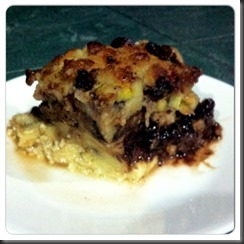 |
Budget conscious cost saving puddings
Source: |
This is a rather long post and I hope you like the post. Feel free to try your own versions and share with me about your own adventures.
Cheers.
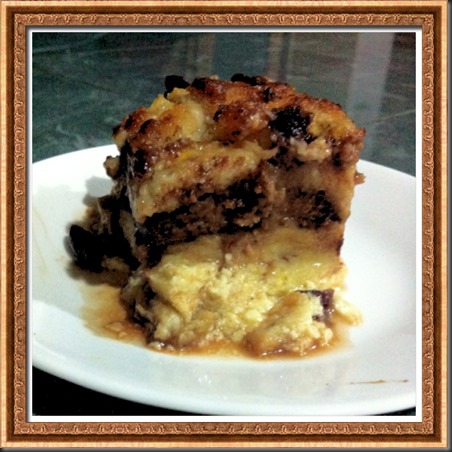
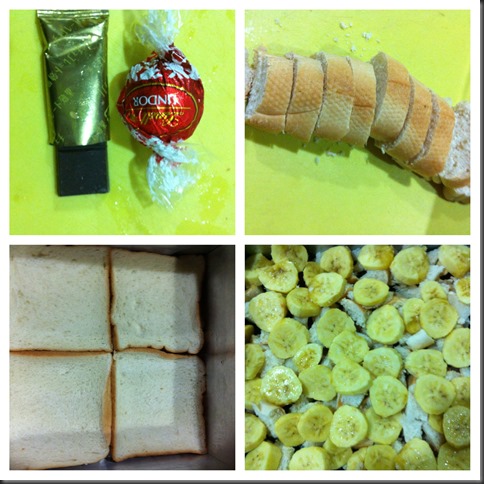
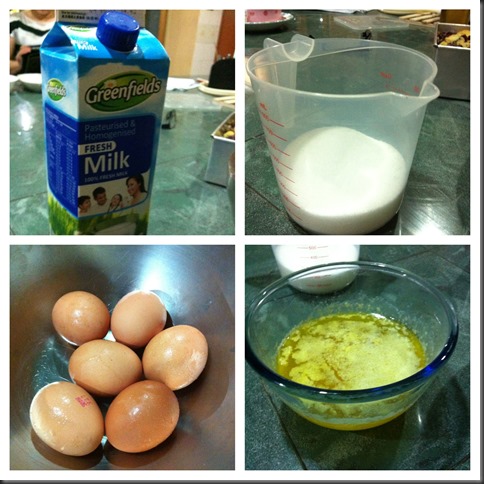
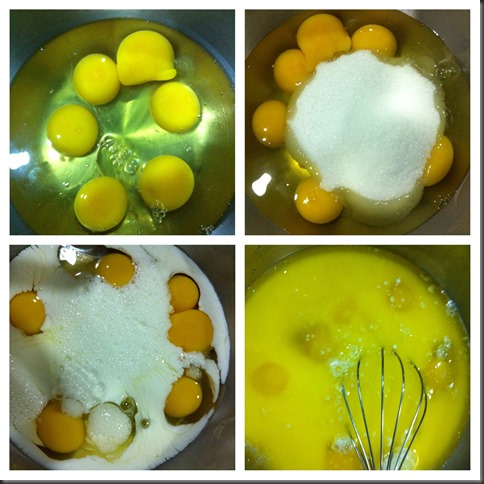
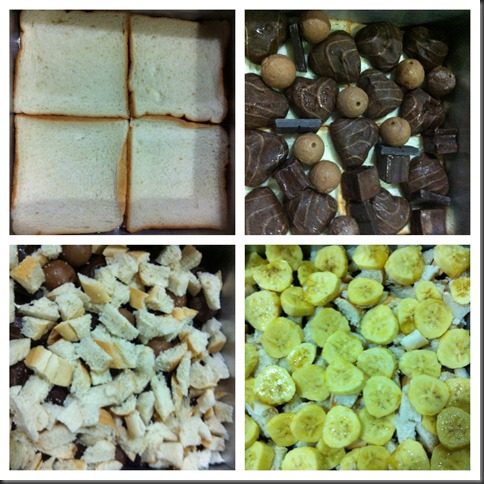
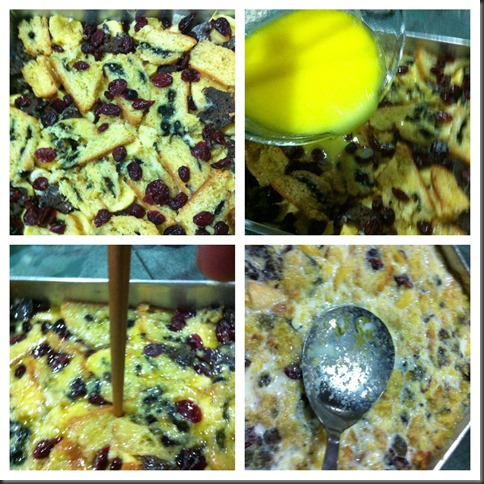
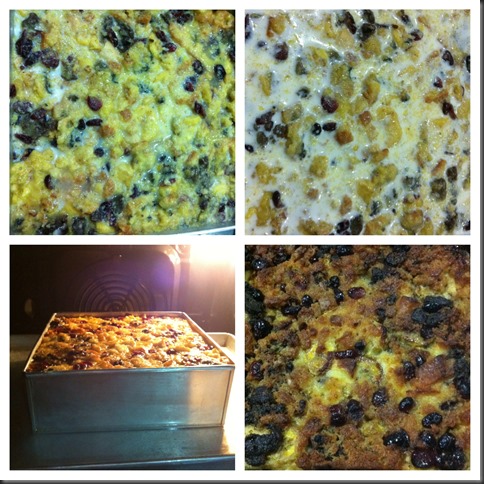

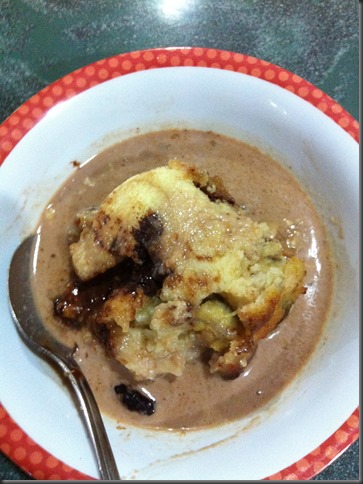
This looks super yummy, I have bookmarked it. Thanks for stopping by my blog and liking my soups. Have a pleasant day!!!
Liz, I think our style of sharing the recipe is very much similar. That is why I like the way you present it. You are a master in this field, I am sure you can share with readers some unusual puddings recipes that you have baked and I am sure readers will be pleased to use this as another reference. Thanks for reading.
Thanks for the compliments . I haven’t posted much on desserts but I started this week. I love your style of presenting too, makes it much easier to follow the recipe. I can never bake from a book without photos, because I always need to see what I am about to make. Have a great weekend.
I like bread pudding a lot. Adding chocolates to it is a twist I never thought about, nor donuts, or eating it with chocolate milk poured over it. I don’t think your picture of bread pudding is ugly either. It looks like bread pudding is supposed to look like – yummy!
Very very frankly, before I baked the puddings, I do not know how it is going to turn out….I seldom repeat my recipe and I believe you will agree, you don’t always have extra chocolates for bread puddings. As far as home baking is concerned, bread puddings are supposed to be a “junk” recipe to get rid of all your stale but edible foods. But if I want to treat this pudding as a posh restaurant dessert, I will definitely consider putting chocolates as the taste was just very different. Adding milk is my kids request and it is really very yummy….. Thanks for reading.
I knew it was for stale bread, but I can see your meaning of using it kind of as a catch all for leftover sweets and things. I definitely will try the chocolates and chocolate milk. It looked really good to me!
I like to eat bread pudding. this is my first try using ur simple recipe. Hope it works!
Sure you can do it!
Pingback: Lots Of Chinese New Year Goodies At Home And Don’t Know What To Do With It?–Cookies and Cakes Puddings | GUAI SHU SHU
Pingback: FOOD PREPARATION SERIES INDEX | Guai Shu Shu